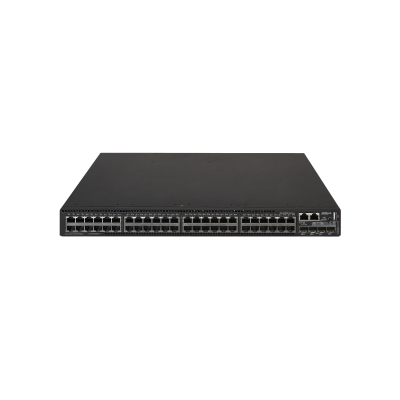S5600-48GT4XF
L3 Managed S56 Series Switch with 48-Port RJ45 and 4-Port SFP+
> Rich layer 3 features
> High availability
> Excellent manageability
> Power saving design
> Comprehensive security control policies
> Support Intelligent Resilient Framework
> Reliable hardware design with modular dual power supply
> High-density 10/100/1000Base-T autosensing Ethernet ports and GE/10GE SFP + fiber ports onboard
Technical Specification
Switching capacity
598Gbps
Packet forwarding rate
144 Mpps
Packet buffer memory
3 Mbit
Dimensions (H × W × D)
43.6 × 440 × 360 mm (1.72 × 17.32 × 14.17 in)
Weight
≤ 8.5 kg (18.74 lb)
Management Ethernet ports
1
Console ports
1 × RJ-45 console port
1 × Micro-USB port
Only the Micro-USB port is available if you connect both ports.
Service ports
48 × 10/100/1000Base-T autosensing Ethernet ports
4 × 1G/10G SFP+ ports
Rated input voltage
AC: 100 VAC to 240 VAC @ 50 Hz/60 Hz
Min. power consumption
Dual AC inputs: 30 W
Max. power consumption
Dual AC inputs: 56 W
Operating temperature
0ºC to 45ºC (32°F to 113°F)
Operating humidity
5% RH to 95% RH, non-condensing
OpenFlow
OpenFlow 1.3
Link aggregation
1G/10G port aggregation
Static aggregation
Dynamic aggregation
Multichassis link aggregation
Port features
802.3x flow control (full-duplex)
Storm suppression based on port bandwidth percentage
Storm suppression based on PPS
Storm suppression based on BPS
Jumbo frame
Supported
MAC address table
16K MAC address entries
Blackhole MAC address
MAC learning limit
VLAN
Port-based VLAN
MAC-based VLAN
Protocol-based VLAN
IP subnet based VLAN
QinQ and flexible QinQ
VLAN mapping
Voice VLAN
MVRP
Loop-free redundant Layer 2 topology
STP/RSTP/MSTP and PVST
Smart Link
RRPP
G.8032 Ethernet ring protection switching (ERPS)
DHCP
DHCP client
DHCP snooping
DHCP relay
DHCP server
DHCP snooping Option 82/DHCP relay Option 82
IRF2
IRF2
Distributed device management, distributed link aggregation, and distributed resilient routing
Stacking through standard Ethernet interfaces
Local device stacking and remote device stacking
IP routing
12K IPV4 routing entries
Static routing
RIPv1/v2 and RIPng
OSPFv1/v2/v3
BGP and BGP4+ for IPv6
IS-IS
VRRP/VRRPv3
IPv6
Neighbor Discovery (ND)
PMTU
IPv6-Ping, IPv6-Tracert, IPv6-Telnet, and IPv6-TFTP
Multicast
IGMP Snooping v1/v2/v3 and MLD Snooping v1/v2
PIM Snooping
MLD Proxy
Multicast VLAN
IGMP v1/v2/v3 and MLD v1/v2
PIM-DM, PIM-SM, and PIM-SSM
MSDP and MSDP for IPv6
MBGP and MBGP for IPv6
Mirroring
Flow mirroring
N:4 port mirroring
Local port mirroring and remote port mirroring
QoS/ACL
Layer 2 to Layer 4 packet filtering
Traffic classification based on source MAC, destination MAC, source IP, destination IP, TCP/UDP port number, and VLAN
Time range-based ACL
QoS/ACL
Bi-directional ACLs (inbound and outbound)
VLAN-based ACL issuing
Rate limit for receiving and transmitting packets (a minimum CIR of 8 Kbps)
Packet redirection
802.1p priority and DSCP priority
Committed Access Rate (CAR)
Eight queues per port (including the CPU port)
Flexible queue scheduling algorithms based on both port and queue, including SP, WRR, WFQ, SP+WRR, and WDRR
WRED
Security
Hierarchical user management and password protection
802.1X authentication and centralized MAC address authentication
Guest VLAN
RADIUS authentication
SSH 2.0
Port isolation
Port security
Portal authentication
DHCP snooping
Dynamic ARP detection
BPDU guard and root guard
uRPF
IP/Port/MAC binding
Plaintext authentication and MD5 authentication for OSPF and RIPv2 packets
Public Key Infrastructure (PKI)
Management and maintenance
Loading and upgrading through XMODEM/FTP/TFTP
Configuration through CLI, Telnet, and console ports
SNMPv1/v2/v3
System log, alarming based on severity, debugging information output
NTP
Power, fan, and temperature alarming
Ping and Tracert
Virtual Cable Test (VCT)
Device Link Detection Protocol (DLDP)
LLDP
Loopback detection
Installation
19-inch rack mounted
Power saving
802.3az EEE
Automatic port power-down
Scheduled port power-down (schedule job)












